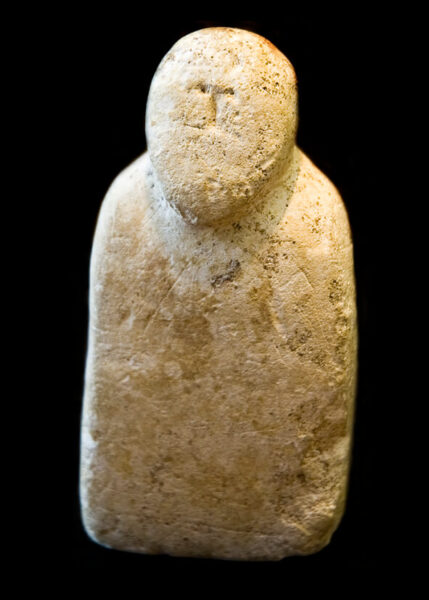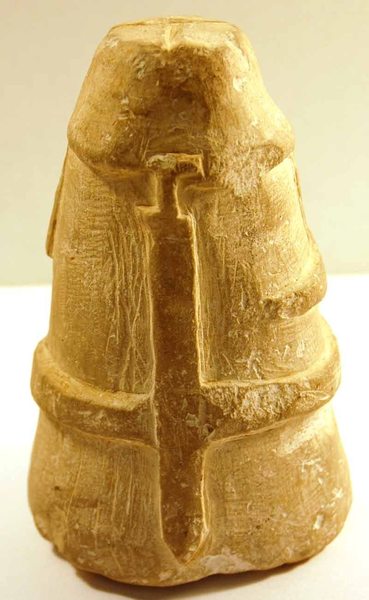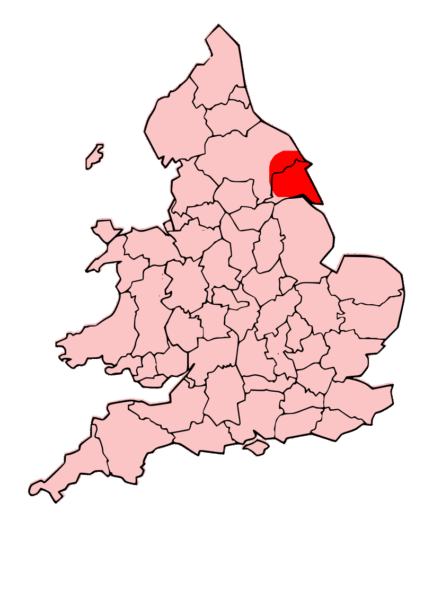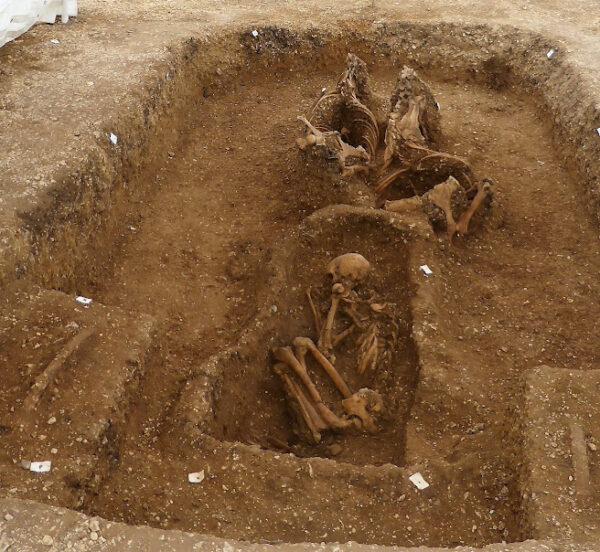During the 1968-78 excavations of the Roman vicus (a civilian settlement) next to the fort here at Malton, some ghostly figures appeared in the trenches beneath the settlement. Unexpectedly, these figures were frozen warriors reaching for a sword, caught mid-action, ready to spring into a fight.

Who Are They?
This dashing figure belongs to a mysterious local tradition of fashioning warrior figures from the chalk of East Yorkshire. Around 40–50 of these figurines survive today. For instance other warriors have been found haunting the soils at the Iron-Age farmstead sites at Garton/Wetwang Slack and Withernsea (Figure 2).

Figure 2. The Witnernsea Chalk Figurine on display in the Hull and East Riding Museum. This little fella is fashioned wearing a hooded cloak, belt and a sword on his back (Izi Travel nd).
Who Made Them?
Our chalk warrior was created during a turbulent century at roughly 100 BC to AD 100, just before the Romans entered the stage with their roads, baths, and bureaucracy.
It is likely that they belong to the Parisi tribe. These guys came from Gaul originally and settled in East Yorkshire (Figure 3).

This tribe brought with them their stunning metalwork and high status burials (Figure 3). They are said to have had been culturally advanced and helped civilise the Brigantes tribes to their north and west.
Archaeologist Paul Treherne wrote a study called The Warrior’s Beauty – essentially an “Iron Age GQ.” He gives us a tantalising glimpse into the mindset behind the Iron Age ‘craze’ for beauty. He thinks warriors were built physically, mentally, and aesthetically. Muscles? Essential. Posture? Perfected. Groomed? Absolutely. If you wanted to fight well, you had to look like a hero first.

Purpose?
We don’t know for sure what they were actually made for. What do we know? These guys were broken deliberately, others buried or discarded nearby water sources like the Lady Spring.
In the comment section, we would love to know what you all think.
Visit
Come find these little fellas in Malton Museum and take a selfie with them – they like the attention!

These chalk warriors seem awfully keen on looking good in their fight club threads! Who needs armour when youve got perfect posture and a killer beard? Maybe they were more concerned with their Instagram presence than actual battle strategy. Its like Iron Age GQ, but if you lost, you *really* wouldnt look like a hero. Honestly, the effort put into looking aesthetically built while probably being physically weak is quite something! Its fascinating, though – these figures were clearly into their personal brand, even if it probably backfired spectacularly in combat.football bros unblocked
These chalk warriors are indeed a striking sight, frozen in their Iron Age GQ poses, ready to spring into a fight… or perhaps just ready for a photoshoot with their swords. Who wouldnt want to look the part before charging into battle? Though their exact purpose remains elusive, its fun to imagine them as ancient fashion accessories or maybe just really keen on pre-Roman self-help. Those broken figures? Maybe they were just early casualties of the Iron Age Instagram wars. Either way, they add a charmingly rugged style to our history.prophecy deltarune
Whoa, hold the chalk! This article is peak Iron Age GQ with its warrior critiques. I love the idea that looking like a hero is non-negotiable for fighting well – sounds like ancient LinkedIn advice. And the Parisi were basically Iron Age influencers, bringing their stunning metalwork and high-status burials, plus civilizing tips on the side. But really, were these figurines just ancient Instagram posts? Check out my chiseled abs and battle-ready cloak! Its fascinating they were so concerned with aesthetics, yet were still left wondering why they broke so many. Maybe they just had terrible photo booth lighting? 😉
Whoa, hold the chalk! This article is *choked* with fascinating insights into these Iron Age fashion icons. Who knew warriors needed to look like *models* before charging into battle? The Warriors Beauty… seriously, Iron Age GQ? Makes sense if you want to intimidate your enemies with *style*. And those Parisi tribe folks, bringing their stunning metalwork and high-status burials – talk about packing a punch, literally and figuratively! Though, the mystery of *why* they were broken remains a bit of a head-scratcher. Still, what a cool glimpse into ancient self-expression! Truly, the *beauty* of the past knows no bounds.basketball bros unblocked
These chalk warriors are indeed frozen in action, ready to spring into a debate about Iron Age fashion sense! Who knew 2,000 years ago people were so into their Iron Age GQ? Our warrior looks like hes ready to strut into battle, not just swing a sword. And those Parisi – bringing their metalwork and, apparently, their high standards for warrior grooming, even if our figurines belt is just a hint. Its fascinating to imagine an Iron Age GQ manual! Though, honestly, its a bit mysterious why these guys were broken deliberately. Maybe they lost a fight over whose belt was cooler? Still, a tantalising glimpse into the mindset, indeed!wheel of names